Three recommendations for a new approach to preventing extremism in fragile states
Despite our success protecting America’s homeland, extremism is spreading. Since 9/11, the number of terrorist attacks worldwide per year has increased fivefold. As long as this continues, the United States will remain vulnerable to terrorism while extremism contributes to chaos, conflict, and coercion that drains U.S. resources, weakens our allies, and provides openings for our competitors.
We need a new strategy to prevent extremism in fragile states. If we can mitigate the underlying conditions that allow extremism to emerge and spread in these states, the United States will be closer to breaking out of the costly cycle of perpetual crisis response, pushing back against the growing threat of extremism, and positioning itself effectively for strategic engagement with its competitors. Recent successes in the fight against the Islamic State make this a unique opportunity to focus on prevention. We must move from defeating terrorists to preventing extremism.
Established in response to a request from the U.S. Congress in 2017, the Task Force on Extremism in Fragile States has developed a new strategy that represents the insightful and bipartisan foreign policy thinking of fifteen leading former policymakers, legislators, and other experts on how to empower fragile states to resist extremism on their own.
1. Adopt a shared policy framework for strategic prevention.
- The United States should adopt a shared, government-wide framework for understanding the underlying conditions of, and solutions to, extremism.
- The framework should recognize extremism as a context-specific, but inherently political and ideological, problem.
- The framework should make the goal of U.S. policy to support and encourage leaders at all levels and in all segments of society—including women, youth, civil society, and the private sector—to listen and respond to the needs of their people.
2. Launch a Strategic Prevention Initiative.
- Congress should authorize and fund, and the Executive Branch implement, a government-wide Initiative that aligns U.S. policy instruments, from foreign assistance to diplomatic engagement, in support of preventing extremism in the Sahel, Horn of Africa, and the Near East.
- The Initiative should aim to promote long-term coordination between U.S. agencies working in fragile states to ensure efficacy and efficiency in the way our government funds projects that prevent extremism.
- The Initiative should set out the roles and responsibilities of each U.S. agency for undertaking prevention, create new mechanisms for oversight and coordination, and grant policymakers flexible authorities to implement a preventative strategy that responds to evolving local needs.
3. Establish a new Partnership Development Fund to rally the international community behind country-led efforts to prevent the underlying conditions of extremism.
- The United States neither can nor should prevent extremism alone. Our government should therefore lead the creation of a multilateral Fund to focus the international community’s attention on prevention and pool international donors’ resources behind a shared, coordinated, and sustained approach to addressing the underlying conditions of extremism in fragile states.
- A Partnership Development Fund would provide an innovative and inclusive international coordination and financing mechanism to align programs and activities and raise and disburse funding for country-led, inclusive programs that address the underlying conditions of extremism.
- A single, unified source of assistance might also entice fragile states that would otherwise look elsewhere for patronage.
The Task Force urges Congress and the administration to take up these recommendations and looks forward to working to implement them.


